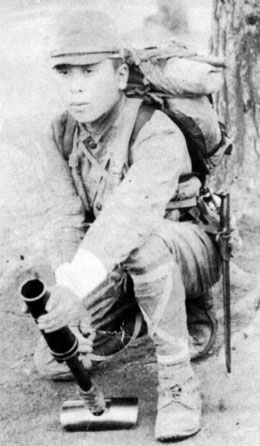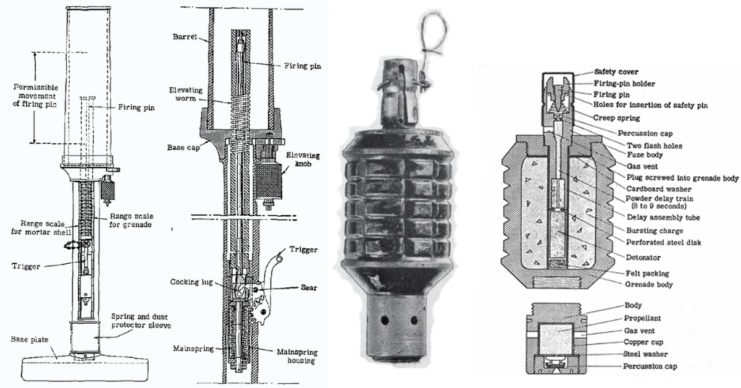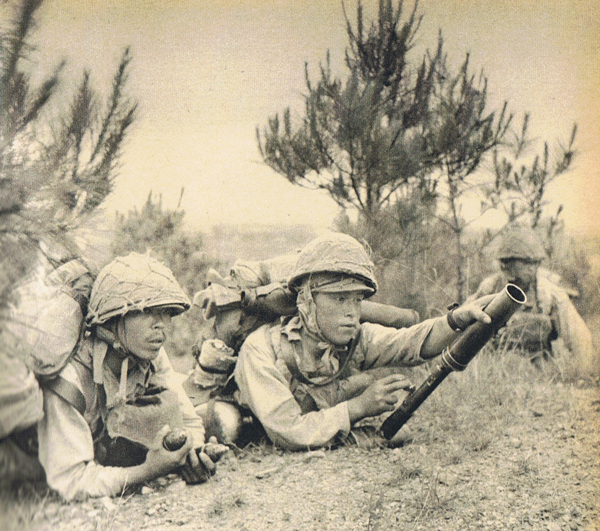During the United States’ war against the Japanese, they often enjoyed a technical advantage in terms of equipment and weapons. US flamethrowers, semi-automatic rifles, shotguns, and submachine guns – not to mention tanks and air power – gave the US an edge. However, one Japanese weapon that was particularly feared by US Marines was the knee mortar. This grenade launcher was easy to use and transport, and had a higher rate of fire. Hurling explosives at a rate of up to 25 a minute, it is believed that the knee mortar caused 40 percent of American casualties in the Pacific.
Its most used name, “knee mortar”, is actually incorrect. Actually known as the Type 89 Grenade Discharger, US troops nicknamed it the knee mortar as for a time it was thought that the weapon was fired by stabilizing it against the user’s leg. Although this probably could have been done in an emergency, this was not how the weapon was meant to be used.
Throughout the war, Japan’s ground forces suffered from rather poor or ineffective equipment. Their tanks were no match for the Sherman, while their anti-tank weapons – some of which were suicide missions – left much to be desired. Even their small arms were outclassed by Allied weapons; especially the Arisaka, which was outmatched by the M1 Garand, and if it was a late war version, had a tendency to blow up in the user’s face.
Part of the reason for these sub-par tools was that Japan invested most heavily into its navy. Knowing they wouldn’t be able to match the US on land, they tried to beat them at sea. Some of their aircraft – like the A6M Zero – were fantastic designs, and their ships were world-class.
Japan’s deadly knee mortar

The knee mortar was a simple, yet extremely effective weapon.
Before the war, the Japanese Army put plenty of effort into optimizing their grenades. They wanted them to be useful in all environments and at all close-combat ranges. The Type 91 fragmentation grenade was a result of this thinking and was a highly adaptable device that could be thrown or launched.
In particular, it could be launched by the knee mortar, which functioned as backup firepower for troops in confined combat.
This weapon was comprised of a 10 inch (25 cm) long rifled barrel atop a spring housing, attached to a rounded base plate. Overall, it was 26 inches (66 cm) long and weighed 4.7 kg (less than a loaded Thompson submachine gun). As mentioned, the knee mortar was not actually fired from the knee. Instead, it would be rested against the ground or any other solid surface and fired at a 45-degree angle. In a pinch, the weapon could fire horizontally if braced against a wall or a tree.
The weapon was easy to use and could be operated by one person, but it was usually accompanied by a three-man crew, who could fire up to 25 rounds a minute. Its 50 mm bore and spring-loaded mechanism could launch a grenade farther than a football field.
The knee mortar could fire either the Type 91 fragmentation grenade or the Type 89 50 mm.

As it was a grenade, the Type 91 did not explode on impact but was detonated by a fuse ignited shortly after launch. While this sounds like a drawback, impact-detonating explosives are hampered in jungle environments by the thick vegetation, which can easily set off the impact fuse. Fused grenades like the Type 91 were useful for passing through vegetation and only exploding once its delay was up. In Type 91’s case, this was around 7-8 seconds.
Meanwhile, the Type 89 was an impact-detonated device and carried much more explosive filling than the Type 91 grenades. It could also come in incendiary and smoke versions.
In dense jungles, the Type 89 shell could be fired upwards through gaps in the jungle’s canopy.
Each Imperial Japanese Army platoon carried three Type 89s, making it their most numerous fire support weapon. In fact, thanks to its simple construction, over 120,000 knee mortars were made. The device was responsible for many American deaths in the Pacific and even impressed Marine legend “Chesty” Puller.
The knee mortar was used after the war by a number of Asian military forces, and some even ended up being used in the Vietnam War.
